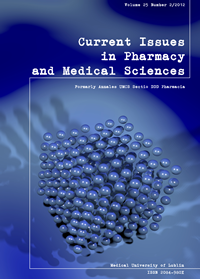The influence of excipients on dissolution of caffeine from granules
DOI:
https://doi.org/10.12923/j.2084-980X/25.2/a.19Keywords:
caffeine, granules, excipients, wet granulation, dissolutionAbstract
Four formulas of granules with caffeine were chosen to examine the influence of excipients on dissolution profiles of active substance from this drug form. The formula I: caffeine 1.0 parts, potato starch 69,3 parts, lactose 29,7 parts, glycerol 86% 2.0 parts, gelatin mucilage 4% (w/w) 98.0 parts; the formula II: caffeine 1.0 parts, Avicel 49,5 parts, lactose 49,5 parts, glycerol 86% 2.0 parts, gelatin mucilage 4% (w/w) 98.0 parts; the formula III: caffeine 1.0 parts, D-Mannitol 99,0 parts, glycerol 86% 2.0 parts, gelatin mucilage 4% (w/w) 98.0 parts and the formula IV: caffeine 1.0 parts, Avicel 49,5 parts, lactose 49,5 parts, and 0.5% solution of PVP 100.0 parts. This solution was prepared by dissolution of 0.5 parts PVP in 95.5 parts of mixture of ethanol 96° and water 1:1 (w/w). The granules were obtained in wet granulator. Their flow properties, moisture content, disintegration time and dissolution of active substance were tested. All granules passed the pharmacopoeial dissolution test because 80% of caffeine dissolved in 10 minutes time.
References
1. Caffeine (2012). In: Martindale: The complete drug reference, medicines complete. London: The Pharmaceutical Press.
2. Cavinato M et al: Combining formulation and process aspects for optimizing the high-shear wet granulation of common drugs. Int. J. Pharm., 416, 229, 2011.
3. Czarnecki W, Szumiło M, Wąsik D: Influence of size and density of particles on flow properties of granules. Act. Pol. Pharm. – Drug Res., 66, 5, 531, 2009.
4. Guo Z et al: An investigation on the correlation between drug dissolution properties and the growth behaviour of granules in high shear mixer. J. Pharm. Pharmacol., 63, 1548, 2011.
5. Kołodziejczyk MK, Zgoda MM: Polimery jako substancje pomocnicze stosowane w technologii tabletek powlekanych zawierających pochodne kwasu ibandronowego (bisfosfoniany). Polim. Med., 42, 1, 5, 2012.
6. Kraciuk R, Sznitowska M: Effect of Different Excipients on the Physical Characteristics of Granules and Tablets with Carbamazepine Prepared with Polyethylene Glycol 6000 by Fluidized Hot-Melt Granulation (FHMG). AAPS Pharm. Sci. Tech., 12, 4, 2011.
7. Polish Pharmacopoeia VI (2002). Warsaw: Urząd Rejestracji Produktów Leczniczych, Wyrobów Medycznych i Produktów Biobójczych.
8. Polish Pharmacopoeia IX, volume I (2011). Warsaw: Urząd Rejestracji Produktów Leczniczych, Wyrobów Medycznych i Produktów Biobójczych.
9. Seppälä K et al: Development of a new method to get a reliable powder flow characteristics using only 1 to 2 g of powder. AAPS Pharm. Sci. Tech., 11, 1, 2010.
10. Szumiło M, Marczuk M: Influence of participation of different apparent density granules on caffeine distribution. Ann. UMCS Sec. DDD, 22, 4, 1, 9, 2009.
Downloads
Published
Issue
Section
License
Copyright (c) 2012 Authors

This work is licensed under a Creative Commons Attribution-NonCommercial-NoDerivatives 3.0 Unported License.


